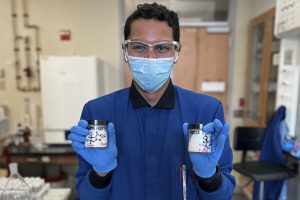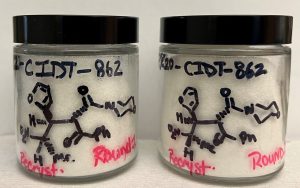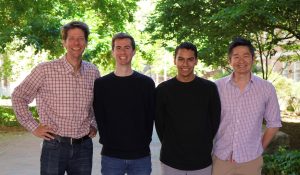Pedro de Jesús Cruz’s tenacious pursuit of organic chemistry research has led to a potentially transformative proof-of-concept in drug synthesis that could transform large-scale manufacturing.
When asked about recent UNC-Chapel Hill graduate Pedro de Jesús Cruz, chemistry professor Jeffrey Johnson’s initial response is about determination.
“Pedro will run through a brick wall to get something done,” says Johnson with a slight chuckle. “He has a phenomenally positive attitude that served him well in our research projects, and he’s just delightful to talk with about science.”

Most recently, this passion resulted in a proof-of-concept study published in Science that aims to solve an issue that frequently arises in the manufacturing of chemicals on a commercial scale: how to create and isolate a desired product without resulting in an abundance of difficult-to-dispose-of byproducts.
But getting to this point in their research required some heavy lifting on de Jesús Cruz’s part.
“For Pedro’s thesis, he created 500 pages worth of supporting information on very difficult mechanistic work to better understand the guts of process chemistry,” Johnson says. “This was published in a peer-reviewed journal, and also helped springboard us into our most recently published study.”
These deep dives are what attracted de Jesús Cruz to the field, and eventually UNC-Chapel Hill, in the first place. But before navigating the waters as a student researcher, he was surfing in the coastal waters of his home, Puerto Rico.
“I was very interested in being outside as a kid, always skateboarding or surfing. I had no idea what I wanted to be going into college,” de Jesús Cruz says.
He started his undergraduate studies at the University of Puerto Rico at Cayey as a computer engineering student. As a prerequisite, he took a general chemistry course, and his chemical romance began.
“I fell in love. I knew chemistry research was what I wanted to do, but I didn’t have many opportunities to pursue it where I lived.”
His quest brought him to UNC-Chapel Hill’s Summer Undergraduate Research Opportunity in Chemistry (SUROC), where he worked in the lab of professor Mark Shoenfisch. de Jesús Cruz continued his education at Carolina with a year-long post baccalaureate program under Shoenfisch’s mentorship. This ultimately led him to apply for graduate school, where he found his calling of organic chemistry.
During his time studying in Chapel Hill, the first-generation college student was also learning English.
“I not only had to learn a new field of chemistry, but I essentially had to relearn how to talk about it in general because of the differences in the English and Spanish languages,” he recalls.
But he pushed forward, delving into complex problems with encouragement and support from professors like Johnson, who was senior author on their most recent proof-of-concept study that revaluates purification techniques in process chemistry, or the large-scale production of chemicals.
Currently, chromatography is commonly used for the purification process, which requires a large amount of solvent — a liquid or gas in which other materials are dissolved — for product purification. This leftover solvent accounts for most of the waste generated in the chemical industry and is neither easy to dispose of safely nor good for the environment.

On a smaller scale, chemists can use a tool for the purification process called crystallization-induced diastereomer transformation (CIDT), which uses minimal amounts of solvents and essentially forces the mixture to purify itself.
“With CIDT, you produce a mixture of products that have different solubilities, but are also in equilibrium with each other,” Johnson explains. “One product can fall out of solution, leaving the other products behind and the mixture will restore its equilibrium. The products that are left in solution continue to convert into what just fell out of solution.”
While CIDT in catalytic reactions with a binary mixture — involving two molecular components — has been used in organic chemistry for more than 100 years, it’s never been successfully proven with a quaternary mixture — involving four molecular components. de Jesús Cruz and Johnson did just that. Using what Johnson calls a “bread-and-butter” organic reaction used frequently in drug development, the research team found what they say was hidden in plain sight: a practical way to reduce cost, time, and waste by combining the creation and purification steps.

Actually proving what these researchers were accomplishing took a lot of time, effort, and resources. That’s where UNC’s Core Facilities came into play. In order to provide proofs of structure of the molecules in their reaction, the research team utilized the X-ray diffraction, nuclear magnetic resonance, and mass spectrometry instruments in the chemistry department’s Core Laboratories. UNC’s Core Facilities provide access to equipment that labs like Johnson’s need on a nearly daily basis.
“When we execute the reaction we need to see what has actually happened,” Johnson says. “All the molecules we were working with had the exact same connections but were arranged differently in space. We use mass spectrometry to see how much a molecule weighs, nuclear magnetic resonance to show what is connected to what, and X-ray to give a three-dimensional map.”
With heavy lifting from co-authors William R. Cassels and Chun-Hsing (Josh) Chen, the study took about a year-and-a-half to complete. The proof-of-concept doesn’t guarantee this method will work for every single chemical system and more research is needed, but it does have impressive implications. By introducing controlled chaos into process chemistry, large-scale manufacturing processes for industries like pharmaceuticals and agricultural chemistry could be transformed.
“If you can access more of the compound in a practical way, we could make chemistry more sustainable,” de Jesús Cruz says.
Pedro de Jesús Cruz graduated in May from UNC-Chapel Hill with a PhD in Chemistry. He is now living in Pennsylvania and is a discovery chemist at Merck.
Jeffrey Johnson is the A. Ronald Gallant Distinguished Professor in the Department of Chemistry within the UNC College of Arts and Sciences.
